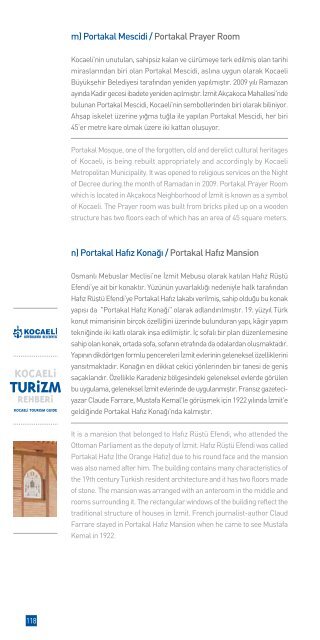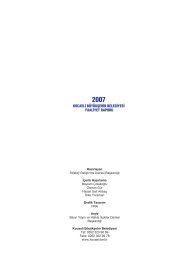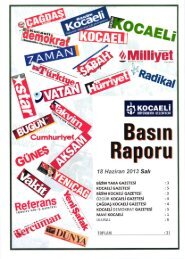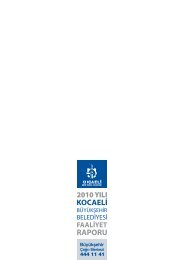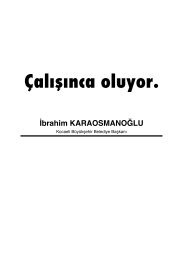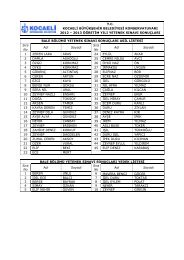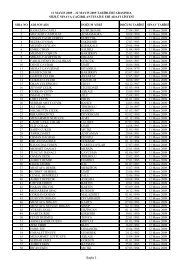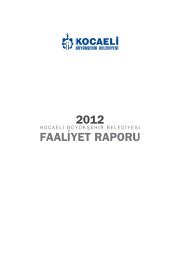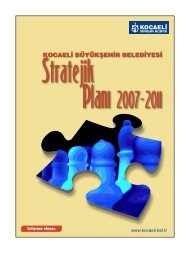Untitled - Kocaeli BüyükÅehir Belediyesi
Untitled - Kocaeli BüyükÅehir Belediyesi
Untitled - Kocaeli BüyükÅehir Belediyesi
Create successful ePaper yourself
Turn your PDF publications into a flip-book with our unique Google optimized e-Paper software.
m) Portakal Mescidi / Portakal Prayer Room<br />
<strong>Kocaeli</strong>'nin unutulan, sahipsiz kalan ve çürümeye terk edilmifl olan tarihi<br />
miraslar›ndan biri olan Portakal Mescidi, asl›na uygun olarak <strong>Kocaeli</strong><br />
Büyükflehir <strong>Belediyesi</strong> taraf›ndan yeniden yap›lm›flt›r. 2009 y›l› Ramazan<br />
ay›nda Kadir gecesi ibadete yeniden aç›lm›flt›r. ‹zmit Akçakoca Mahallesi'nde<br />
bulunan Portakal Mescidi, <strong>Kocaeli</strong>'nin sembollerinden biri olarak biliniyor.<br />
Ahflap iskelet üzerine y›¤ma tu¤la ile yap›lan Portakal Mescidi, her biri<br />
45’er metre kare olmak üzere iki kattan olufluyor.<br />
Portakal Mosque, one of the forgotten, old and derelict cultural heritages<br />
of <strong>Kocaeli</strong>, is being rebuilt appropriately and accordingly by <strong>Kocaeli</strong><br />
Metropolitan Municipality. It was opened to religious services on the Night<br />
of Decree during the month of Ramadan in 2009. Portakal Prayer Room<br />
which is located in Akçakoca Neighborhood of ‹zmit is known as a symbol<br />
of <strong>Kocaeli</strong>. The Prayer room was built from bricks piled up on a wooden<br />
structure has two floors each of which has an area of 45 square meters.<br />
n) Portakal Haf›z Kona¤› / Portakal Haf›z Mansion<br />
Osmanl› Mebuslar Meclisi’ne ‹zmit Mebusu olarak kat›lan Haf›z Rüfltü<br />
Efendi’ye ait bir konakt›r. Yüzünün yuvarlakl›¤› nedeniyle halk taraf›ndan<br />
Haf›z Rüfltü Efendi’ye Portakal Haf›z lakab› verilmifl, sahip oldu¤u bu konak<br />
yap›s› da "Portakal Haf›z Kona¤›" olarak adland›r›lm›flt›r. 19. yüzy›l Türk<br />
konut mimarisinin birçok özelli¤ini üzerinde bulunduran yap›, kâgir yap›m<br />
tekni¤inde iki katl› olarak infla edilmifltir. ‹ç sofal› bir plan düzenlemesine<br />
sahip olan konak, ortada sofa, sofan›n etraf›nda da odalardan oluflmaktad›r.<br />
Yap›n›n dikdörtgen formlu pencereleri ‹zmit evlerinin geleneksel özelliklerini<br />
yans›tmaktad›r. Kona¤›n en dikkat çekici yönlerinden bir tanesi de genifl<br />
saçaklar›d›r. Özellikle Karadeniz bölgesindeki geleneksel evlerde görülen<br />
bu uygulama, geleneksel ‹zmit evlerinde de uygulanm›flt›r. Frans›z gazeteciyazar<br />
Claude Farrare, Mustafa Kemal'le görüflmek için 1922 y›l›nda ‹zmit'e<br />
geldi¤inde Portakal Haf›z Kona¤›'nda kalm›flt›r.<br />
It is a mansion that belonged to Haf›z Rüfltü Efendi, who attended the<br />
Ottoman Parliament as the deputy of ‹zmit. Haf›z Rüfltü Efendi was called<br />
Portakal Haf›z (the Orange Haf›z) due to his round face and the mansion<br />
was also named after him. The building contains many characteristics of<br />
the 19th century Turkish resident architecture and it has two floors made<br />
of stone. The mansion was arranged with an anteroom in the middle and<br />
rooms surrounding it. The rectangular windows of the building reflect the<br />
traditional structure of houses in ‹zmit. French journalist-author Claud<br />
Farrare stayed in Portakal Haf›z Mansion when he came to see Mustafa<br />
Kemal in 1922.<br />
118


